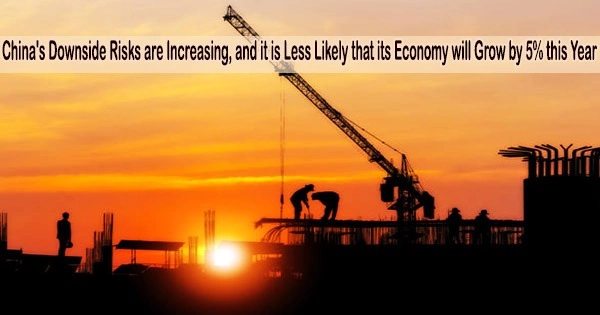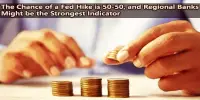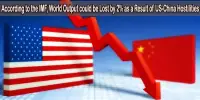Without additional assistance, economists believe China will gradually miss its 5% growth goal for this year.
The nation stopped publishing data on youth unemployment on Tuesday (August 15, 2023) after it reached record highs recently. Other data for July showed a broad slowdown, worsened by the property market slump.
“Prolonged weakness in property construction will add to destocking pressures in the industrial space and depress consumption demand as well,” Tao Wang, head of Asia economics and chief China economist at UBS Investment Bank, said in a note.
“In such a case, economic momentum may stay subdued in the rest of the year and China may miss this year’s growth target of around 5%,” she said. “Deflation pressures could persist longer in such a scenario. The economy would then warrant much stronger or unconventional policies to revive.”
China is the world’s second-largest economy, and accounted for nearly 18% of global GDP in 2022, according to World Bank data.
“In our view, Beijing should play the role of lender of last resort to support some major developers and financial institutions in trouble, and should play the role of spender of last resort to boost aggregate demand,” Nomura’s Chief China Economist Ting Lu and a team said in a report Tuesday.
“We also see bigger downside risk to our 4.9% y-o-y growth forecast for both Q3 and Q4, and it is increasingly possible that annual GDP growth this year will miss the 5.0% mark,” the report said.
Headline risk
Beijing has acknowledged economic challenges and signaled more policy support. The People’s Bank of China unexpectedly cut key rates on Tuesday.
However, the changes need time to take hold and haven’t done much to boost market confidence thus far, particularly as worrying reports increase.
In the years to come, China’s emerging strategic sectors including green economy sectors, digital economy, advanced and semiconductor manufacturing will continue to be the ones to watch as China transitions to new growth drivers.
Louise Loo
“In August, contagion fears around property developers and default risk in the trust industry have also pushed sentiment lower, setting a higher bar for stimulus to be effective,” said Louise Loo, lead economist at Oxford Economics.
A firmer policy shift could come in the fourth quarter, when a top-level meeting known as the “Third Plenum” is expected to be held, Loo said.
Once-healthy giant developer Country Garden is now on the brink of default. In other news this month, Zhongrong International Trust missed payments to three mainland China-listed companies, according to disclosures accessed via Wind Information.
Zhongrong did not immediately respond to a CNBC request for comment. Its website warned in a notice dated Aug. 13 of fraudulent claims that it was no longer able to operate.
Even if all of Zhongrong’s 630 billion yuan ($86.5 billion) in assets plus leverage were in trouble, that’s “not a systemically threatening number” for China’s 21 trillion yuan trust industry and 315 trillion yuan banking system, Xiangrong Yu, Citi’s chief China economist said in a note.
He added the trust firm and its parent company are “much less connected in the financial system compared with previous cases such as Baoshang Bank and Anbang Group.”
Growth vs. national security
Chinese authorities’ initial crackdown on real estate developers in 2020 was an attempt to curb their high reliance on growth. Beijing emphasized this year that defusing financial risks is one of its priorities. This year, the country is also in the process of reorganizing its financial regulatory bodies.
As local government debt remained high, cash levels have fallen, according to a Rhodium report in June. It noted regional authorities have spent money to buy land, to fill demand that once came from developers.
“The current weakness of localities’ finances prevents Beijing from utilizing fiscal policy to support the economy,” Rhodium analysts said.
For many, especially overseas investors, prolonged apparent inaction can affirm the Chinese government has firmly shifted its priorities as well.
“A tepid response to the cratering housing market would indicate that the top leadership’s reduced emphasis on economic growth in favor of priorities like national security and technological self-sufficiency is more far-reaching than we anticipated,” Gabriel Wildau, managing director at consulting firm Teneo, said in a report Tuesday.
“Our base case is that policymakers will significantly escalate housing stimulus in coming months, leading to improving sales and construction volumes by year end,” Wildau said.
Many of China’s recent troubles are not necessarily new. China has been in a multi-year process to try to improve the long-term sustainability of its economy, and shift away from reliance on investment into sectors such as infrastructure and real estate, and toward consumption.
“The challenge for policymakers is to calibrate stimulus that avoids an economic hard-landing on one hand, but that also smoothly transitions property and investments to their nascent downtrend on the other,” said Loo from Oxford Economics.
“In the years to come, China’s emerging strategic sectors including green economy sectors, digital economy, advanced and semiconductor manufacturing will continue to be the ones to watch as China transitions to new growth drivers,” Loo said.
She pointed out that high-tech manufacturing’s year-to-date average year-on-year growth of 7.4% has outpaced industrial production’s roughly 3.8% pace.
















